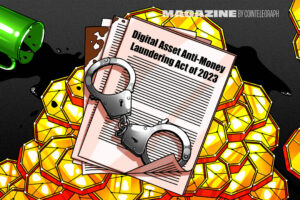
Bitcoin’s price gave back some of its recent gains this week, but multiple data points suggest that $30,000 should hold as support going forward.
Bitcoin (BTC) remained within a narrow 4.3% range for the 15 days leading up to July 7. Despite the proximity of the $29,895 to $31,165 range, investors’ sentiment was significantly impacted by an unsuccessful attempt to break above $31,400 on July 6.
Traders’ tendency to overreact to short-term price movements rather than Bitcoin’s year-to-date gains of 82% could be part of the reason for the short-term correction. This same rationale applies to the events related to other cryptocurrencies.
At the forefront of investors’ minds are questions about whether the recent price gains were solely driven by multiple spot Bitcoin exchange-traded fund (ETF) requests.
Other pressing developments include Binance’s chief strategy officer, Patrick Hillmann, and other top compliance officers reportedly leaving the exchange on July 6 over CEO Changpeng Zhao’s response to the United States Justice Department’s investigation. On June 29, the crypto exchange also informed users that its euro banking payment gateway would cease services by September, potentially halting deposits and withdrawals via SEPA bank transfer.
Meanwhile, the yield curve on interest rates reached its deepest inversion since 1981 on July 3, reflecting the two-year note’s 4.94% yield compared to the 10-year note trading at 3.86%, the opposite of what is expected from longer-term bonds. The phenomenon is closely watched by investors, as it has preceded past recessions.
All of these events are likely having some impact on the Bitcoin price and investor sentiment. Both topics are explored in greater depth below.
Traders show strength in margin, options and futures markets
OKX stablecoin/BTC margin lending ratio. Source: OKX
The OKX margin lending indicator based on the stablecoin/BTC ratio has steadily increased from 20x favoring longs on July 1 to the current 29x ratio on July 7, indicating growing confidence among traders using margin lending. However, it remains within a neutral-to-bullish range, below the historical 30x threshold associated with excessive optimism.
Besides leaving room for further long leverage, the indicator shows no signs of potential stress on margin markets in case of a sudden Bitcoin price correction.
Traders aren’t buying protective puts or increasing their shorts
Traders can also gauge the market’s sentiment by measuring whether more activity is going through call (buy) options or put (sell) options. A 0.70 put-to-call ratio indicates that put option open interest lags the more bullish calls and is, therefore, bullish. In contrast, a 1.40 indicator favors put options, which can be deemed bearish.
BTC options volume put-to-call ratio. Source: Laevitas
The put-to-call ratio for Bitcoin options volume has remained below 1.0 for the past three days, suggesting a higher preference for neutral-to-bullish call options. The important thing here is, despite Bitcoin’s price briefly correcting to $29,750 on July 7, there was not a significant surge in demand for protective put options.
The top traders’ long-to-short net ratio excludes externalities that might have solely impacted the options markets. There are occasional methodological discrepancies between different exchanges, so readers should monitor changes instead of absolute figures.
Exchanges’ top traders’ long-to-short ratio. Source: CoinGlass
The long-to-short ratio for OKX’s top traders increased from 0.52 on July 3 to 1.68 on July 7, indicating strong demand for leveraged long positions despite Bitcoin’s failure to break above $31,000. At Binance, the indicator declined from 1.52 on July 3 to 1.39 on July 7, remaining above its 1.33 average for the previous 30 days, which suggests a neutral reading.
Related: Bitcoin mining stocks outperform BTC in 2023, but on-chain data points to a potential stall
Bears will have a tough time given the markets’ expectation of a potential ETF approval
Natalie Brunell, an award-winning TV journalist, podcast host and educator in the Bitcoin space, spoke to Cointelegraph on how crypto is now being taken more seriously as an asset class by institutional investors, as evidenced by the multiple Bitcoin ETF filings, including by some of the world’s largest asset fund managers.
Speaking on Fox Business on July 5, Larry Fink, the CEO of BlackRock, also said that Bitcoin’s role was largely “digitizing gold,” suggesting U.S. regulators consider how a spot ETF could democratize finance. Fink suggested that investors could turn to Bitcoin as a hedge against inflation or the devaluation of certain currencies.
So, from a bird’s-eye view, for those questioning whether Bitcoin is poised for a correction after a rally fueled by ETF hype, the resilience of traders’ bullish conviction and lack of excessive optimism observed in the BTC margin show they need to relax.
Bitcoin options and futures markets indicate that challenging times are ahead for Bitcoin bears and those expecting a sharp price correction solely due to regulatory and recessionary concerns.
This article is for general information purposes and is not intended to be and should not be taken as legal or investment advice. The views, thoughts, and opinions expressed here are the author’s alone and do not necessarily reflect or represent the views and opinions of Cointelegraph.
This article does not contain investment advice or recommendations. Every investment and trading move involves risk, and readers should conduct their own research when making a decision.
















